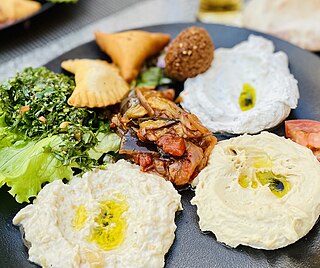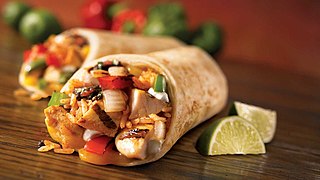
Moroccan cuisine is the cuisine of Morocco, fueled by interactions and exchanges with many cultures and nations over the centuries. Moroccan cuisine is usually a mix of Arab, Berber, Andalusi, and Mediterranean cuisines, with minimal European and sub-Saharan influences. Like the rest of the Maghrebi cuisine, Moroccan cuisine has more in common with Middle Eastern cuisine than with the rest of Africa.
Indian cuisine consists of a variety of regional and traditional cuisines native to the Indian subcontinent. Given the diversity in soil, climate, culture, ethnic groups, and occupations, these cuisines vary substantially and use locally available spices, herbs, vegetables, and fruits.

Bengali cuisine is the culinary style of Bengal, that comprises Bangladesh and the Indian states of West Bengal, Tripura and Assam's Karimganj district. The cuisine has been shaped by the region's diverse history and climate. It is known for its varied use of flavours including mustard oil, as well as the spread of its confectioneries and desserts. There is a strong emphasis on rice as a staple, with fish traditionally the most common protein. Freshwater fish are preferred to seafish, although barramundi, known as bhetki, is also common. Meat is also a common protein among Bengalis with chicken and mutton meat being the most popular. Beef is popular within the muslim community. In more recent times, lentils have begun to form a significant part of the diet. Many Bengali food traditions draw from social activities, such as adda, Poila Boishakh, Mezban, Iftar and Eid feast.

A national dish is a culinary dish that is strongly associated with a particular country. A dish can be considered a national dish for a variety of reasons:
African cuisine is a staple of the continent's culture, and its history is entwined with the story of the native people of Africa. The foods that native Africans eat have been influenced by their religions, as well as by their climates and lifestyles. The first Africans to inhabit the continent were hunter-gatherers who ate what they could find in nature. As agriculture became more common in Africa, so did agriculture-based diets.

Arab cuisine collectively refers to the regional culinary traditions of the Arab world, consisting of the Maghreb and the Mashriq. These cuisines are centuries old and reflect the culture of trading in ingredients, spices, herbs, and commodities among the Arabs. The regions have many similarities, but also unique traditions. They have also been influenced by climate, cultivation, and mutual commerce.

Iranian cuisine is the culinary traditions of Iran. Due to the historically common usage of the term "Persia" to refer to Iran in the Western world, it is alternatively known as Persian cuisine, despite Persians being only one of a multitude of Iranian ethnic groups who have contributed to Iran's culinary traditions.

Sephardic Jewish cuisine, belonging to the Sephardic Jews—descendants of the Jewish population of the Iberian Peninsula until their expulsion in 1492—encompassing traditional dishes developed as they resettled in the Ottoman Empire, North Africa, and the Mediterranean, including Jewish communities in Turkey, Greece, Bulgaria, North Macedonia, and Syria, as well as the Sephardic community in the Land of Israel. It may also refer to the culinary traditions of the Western Sephardim, who settled in Holland, England, and from these places elsewhere. The cuisine of Jerusalem, in particular, is considered predominantly Sephardic.

Jharkhandi cuisine is the cuisine of the Indian state of Jharkhand. Staple foods are rice, dal and vegetables. Common meals often consist of vegetables that are cooked in various ways, such as curried, fried, roasted and boiled. Many traditional dishes of Jharkhand may not be available at restaurants.

A burrito in Mexico is, historically, a regional name, among others, for what is known as a taco, a tortilla filled with food, in other parts of the country. The term burrito was regional, specifically from Guanajuato, Guerrero, Michoacán, San Luis Potosí and Sinaloa, for what is known as a taco in Mexico City and surrounding areas, and codzito in Yucatán and Quintana Roo. Due to the cultural influence of Mexico City, the term taco became the default, and the meaning of terms like burrito and codzito were forgotten, leading many people to create new meanings and folk histories.

Harissa is a hot chili pepper paste, native to the Maghreb. The main ingredients are roasted red peppers, Baklouti peppers (بقلوطي), spices and herbs such as garlic paste, caraway seeds, coriander seeds, cumin and olive oil to carry the oil-soluble flavors.

The Cuisine of Asunción refers to the cuisine and restaurants of the city of Asunción, Paraguay. Compared to most of the Latin American capitals, the city has comparatively few European restaurants and influences in cuisine. However, international and traditional Paraguayan cuisines are available in various restaurants and hotels.

Shebakia or Chebakia, also known as Griwech or Griouech, is a Maghrebi pastry made of strips of dough rolled to resemble a rose, deep-fried until golden, then coated with a syrup made of honey and orange blossom water and sprinkled with sesame. It is typically consumed during Ramadan and religious celebrations. Chebakia is from the Ottoman desserts culture.

Zambian cuisine offers a range of dishes, which primarily features nshima, a staple thick porridge crafted from maize flour, locally known as mealie meal. Nshima itself is quite plain, but it is typically accompanied by an array of traditional Zambian side dishes that introduce a spectrum of flavors to the meal.

















































